Average Single Family Starter Home in Miami Fl
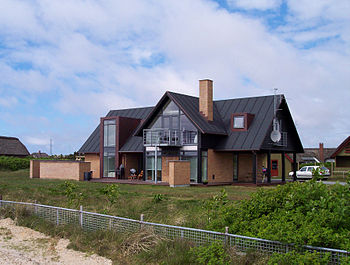
A stand-alone firm (also called a single-detached habitation, detached residence or detached house) is a free-standing residential building. It is sometimes referred to as a unmarried-family home, every bit opposed to a multi-family unit residential dwelling.
Definitions [edit]
A single discrete dwelling contains but i dwelling unit and is completely separated past open infinite on all sides from any other construction, except its own garage or shed.
—Statistics Canada[1]
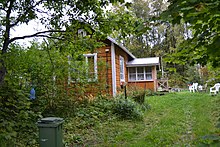
A small discrete business firm surrounded by a dark-green yard in Haapamäki, Keuruu, Finland
The definition of this type of house may vary between legal jurisdictions or statistical agencies. The definition, withal, generally includes two elements:
- Single-family unit (home, firm, or dwelling house) means that the building is usually occupied by just one household or family, and consists of just one dwelling unit or suite. In some jurisdictions allowances are made for basement suites or mother in law suites without irresolute the description from "single family". Information technology does exclude, however, any short-term accommodation (hotel, motels, inns), large-scale rental accommodation (rooming or boarding houses, apartments), or condominia.
- Detached (house, home, or home) ways that the building does not share wall with other houses. This excludes duplexes, threeplexes, fourplexes, or linked houses, as well as all row houses and most especially tower blocks which can concur hundreds of families in a unmarried building.
Most single-family homes are congenital on lots larger than the structure itself, adding an area surrounding the house, which is unremarkably called a yard in Northward American English or a garden in British English. Garages can also be found on almost lots. Houses with an attached front entry garage that is closer to the street than whatsoever other role of the business firm is often derisively called a snout firm.
Regional terminologies [edit]
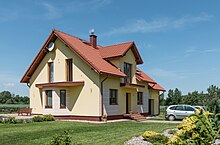
Typical suburban single-family house in Poland

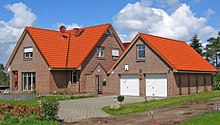
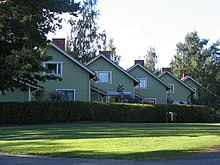
Typical Finnish postal service-Earth War II single-family houses in Jyväskylä
Terms corresponding to a single-family detached home in common use are unmarried-family unit home (in the US and Canada), single-detached dwelling (in Canada), detached firm (in the U.k. and Canada), and separate house (in New Zealand).[ citation needed ]
In the Uk, the term single-family dwelling is almost unknown, except through Internet exposure to US media. Whereas in the U.s., housing is ordinarily divided into "unmarried-family homes", "multi-family dwellings", "condo/townhouse", etc., the main sectionalization of residential belongings in British terminology is between "houses" (including "detached", "semi-discrete", and "terraced" houses and bungalows) and "flats" (i.e., "apartments" or "condominiums" in American English).[ commendation needed ]
History and distribution [edit]

In pre-industrial societies, near people lived in multi-family dwellings for most of their lives. A child lived with their parents from birth until wedlock, so generally moved in with the parents of the homo (patrilocal) or the woman (matrilocal), so that the grandparents could help heighten the immature children and so the center generation could care for their aging parents. This type of arrangement likewise saved some of the attempt and materials used for construction and, in colder climates, heating. If people had to move to a new place or were wealthy plenty, they could build or buy a home for their ain family, but this was not the norm.
The idea of a nuclear family living separately from their relatives equally the norm is a relatively recent evolution related to rising living standards in N America and Europe during the early modern and modern eras. In the New World, where land was plentiful, settlement patterns were quite different from the close-knit villages of Europe, meaning many more people lived in big farms separated from their neighbors. This has produced a cultural preference in settler societies for privacy and space. A countervailing trend has been industrialization and urbanization, which has seen more and more people around the world motility into multi-story apartment blocks. In the New World, this blazon of densification was halted and reversed post-obit the 2nd World State of war when increased motorcar buying and cheaper building and heating costs produced suburbanization instead.
Single-family homes are now common in rural and suburban and even some urban areas across the New Globe and Europe, as well as wealthier enclaves within the Third World. They are near common in low-density, high-income regions. For example, in Canada, co-ordinate to the 2006 census, 55.3% of the population lived in single-detached houses, but this varied substantially past region. In the city of Montreal, Quebec, Canada's second-well-nigh populous municipality, only seven.v% of the population lived in single-discrete homes, while in the city of Calgary, the third-almost populous, 57.8% did.[three] Note that this includes the "metropolis limits" populations but, not the wider region. Culturally, unmarried-family houses are associated with suburbanization in many parts of the world. Owning a home with a thousand and a "white picket fence" is seen as a key component of the "American dream" (which likewise exists with variations in other parts of the world).[4]
In the 21st century, a lack of affordable housing, the climate change impacts of urban sprawl, and concerns well-nigh racial inequality has increasingly led cities to abandon single-family unit housing in favor of college-density homes.[4] [v]
Separating types of homes [edit]
Firm types include:
- Cottage, a small business firm. In the United states, a cottage typically has four master rooms, 2 either side of a key corridor. It is common to find a lean-to added to the back of the cottage which may accommodate the kitchen, laundry and bathroom. In Commonwealth of australia, it is common for a cottage to take a verandah across its front. In the UK and Ireland, whatever small, old (especially pre-World State of war I) house in a rural or formerly rural location whether with one, two or (rarely) iii storeys is a cottage.
- Bungalow, in American English language this term describes a medium- to large-sized freestanding house on a generous block in the suburbs, with generally less formal floor program than a villa. Some rooms in a bungalow typically have doors which link them together. Bungalows may feature a apartment roof. In British English, it refers to whatsoever single-storey house (much rarer in the United kingdom than the US).
- Villa, a term originating from Roman times, when information technology was used to refer to a large house which 1 might retreat to in the country. In the late 19th and early on 20th centuries, villa suggested a freestanding comfortable-sized house, on a large cake, mostly found in the suburbs. In Victorian terraced housing, a villa was a business firm larger than the average byelaw terraced house, often having double street frontage.
- Mansion, a very large, luxurious business firm, typically associated with exceptional wealth or elite, usually of more than one story, on a very large block of country or manor.
Mansions usually will have many more rooms and bedrooms than a typical unmarried-family home, including specialty rooms, such as a library, written report, conservatory, theater, greenhouse, infinity pool, bowling aisle, or server room.
Many mansions are besides large to be maintained solely by the owner, and as such there volition be maintenance staff. This staff may besides live on site in 'servant quarters'.
See besides [edit]
- Semi-detached
- Unmarried-family zoning
References [edit]
- ^ "Spending Patterns in Canada: Data quality, concepts and methodology: Definitions". world wide web.statcan.gc.ca.
- ^ "Saitta Business firm – Written report Part one Archived 2008-12-16 at the Wayback Machine",DykerHeightsCivicAssociation.com
- ^ Canada, Government of Canada, Statistics. "Statistics Canada: 2006 Customs Profiles". www12.statcan.ca.
- ^ a b Dillon, Liam (May 13, 2019). "California could bring radical change to single-family home neighborhoods". Los Angeles Times . Retrieved 2019-05-xiii .
- ^ "The Upzoning Wave Finally Catches Up to California". Bloomberg.com. one March 2021. Retrieved 2 March 2021.
External links [edit]
- "Australian Housing Types" (PDF). Your House teacher resource kit. Royal Australian Institute of Architects. Archived from the original (PDF) on 2006-06-26. Retrieved fifteen January 2006.
Source: https://en.wikipedia.org/wiki/Single-family_detached_home
0 Response to "Average Single Family Starter Home in Miami Fl"
Post a Comment